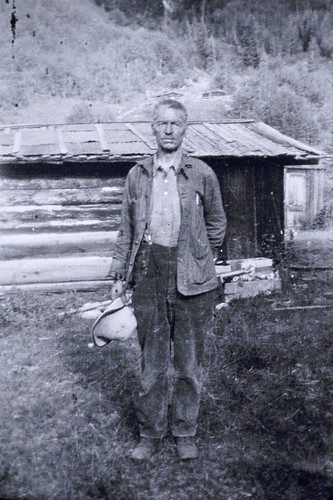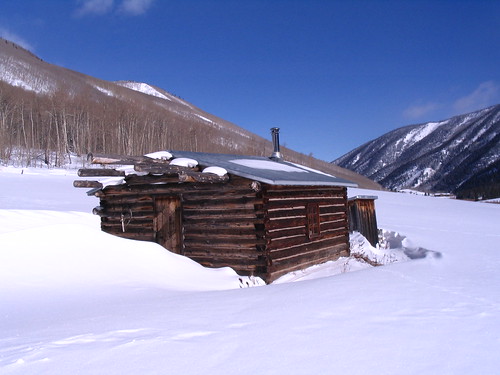Jack Leahy’s Cabin
 |
| © Ann Hodges photo |
Looking north from the welcome point, you can see a building that was important to this town. The silver-roofed cabin across the willows is Jack Leahy’s cabin. Jack was the poet laureate of Ashcroft. He came here in the summer of 1880 right when the town was founded. He left in 1930.Jack was a character—to say the least. He used to write fancy script letters for miners to send back east, and he would enclose a poem for a dollar extra. He was a learned man. He read everything he could get his hands on—Plato, Aristotle, Shakespeare, Voltaire. He was the Justice of the Peace in Ashcroft, although he never ran a trial. Lawyers from Aspen used to travel to Ashcroft to get legal advice from Jack. Leahy ran for the Colorado state legislature twice—he lost both times. Jack was also a union organizer in Aspen with the miners there. He stopped a strike once by quoting Voltaire, saying something like —"Anarchy is the death of civilization."
^ This is believed to be Jack Leahy, in the black suit and tie, at Tim Kelleher's Bar (now the Red Onion) in Aspen, c. 1920.
For all his mental prowess, however, Jack was not a practical man. They think another miner built his cabin. When it was completed, Jack cut a hole in the front door and punched a hole in his wood stove. Jack would feed Aspen trees through the two holes, and, therefore, save himself the trouble of chopping wood save himself the trouble of chopping wood.
^ Jack Leahy and some of his friends stand in front of the Blue Mirror Saloon, c. 1910. Photo courtesy of the Colorado State Historical Society.
A doctor from Aspen finally came up and got the poet of Ashcroft in 1930. Jack was dying of malnutrition. The doctor took Leahy to California, but Jack made his way back to this area and died in Glenwood Springs in 1939.
Jack’s poetry still survives. Some of it is interesting, some is awful. This one is titled How We Built a Church in Ashcroft. It was written in 1880, and it's signed "Jack Leahy, Poet of the Elk Mountains."
How We Built a Church in Ashcroft.
Come all ye Irish Gentlemen, a story I would tell
Of St. Tim’s church at Ashcroft and all that there befell.
Since snows did fall and streams run down from lofty Castle Peak,
More witching spot could ne’er be found, or poet man to speak;
Or lovely vales, bestrewn with flowers, or columbine more rare;
Or sparkling waters foaming down, or azure skies more fair.
The faithful met at Paddy’s, with chairman Deacon Perch;
Six trustees were elected and empowered to build a church.
The reason why—the camp was shocked one evening’s stage to meet,
A portly dame, one Madame Nobbs, with six from Holiday Street.
We were all high protectionists, or, as the case may be,
The vote stood ninety-nine to one ‘gainst reciprocity.
Those are the opening two stanzas of a twenty stanza poem. Jack had a very lively sense of humor. This poem is in the format of a joke. The punch-line is that the church was never built in Ashcroft because the townsfolk could not agree where to place the building. With the community divided, the trustees could only raise enough money to build a rough structure. Madame Nobbs and her prostitutes moved into the rough structure and turned the would-be church into a brothel. Finally, Jack had a snow-slide come down from one of these mountains and level the whole affair for poetic justice.
(http://www.heritageaspen.org/acleahys.html)






No hay comentarios:
Publicar un comentario